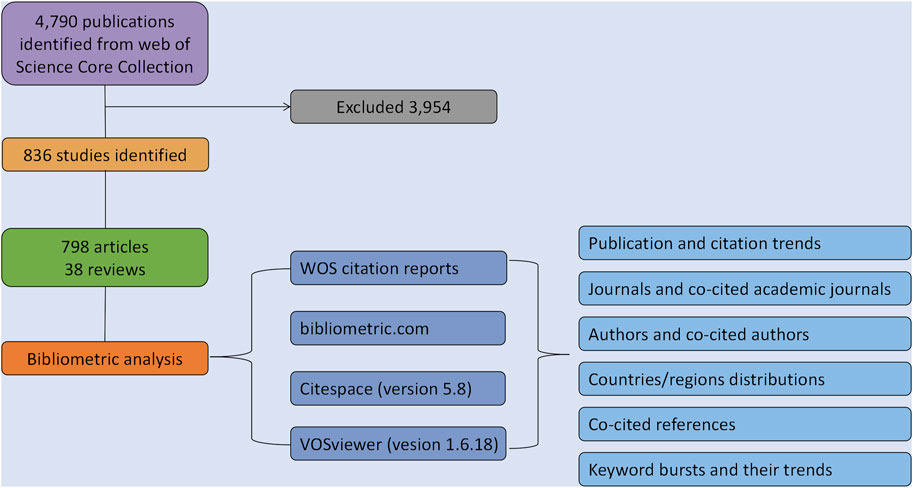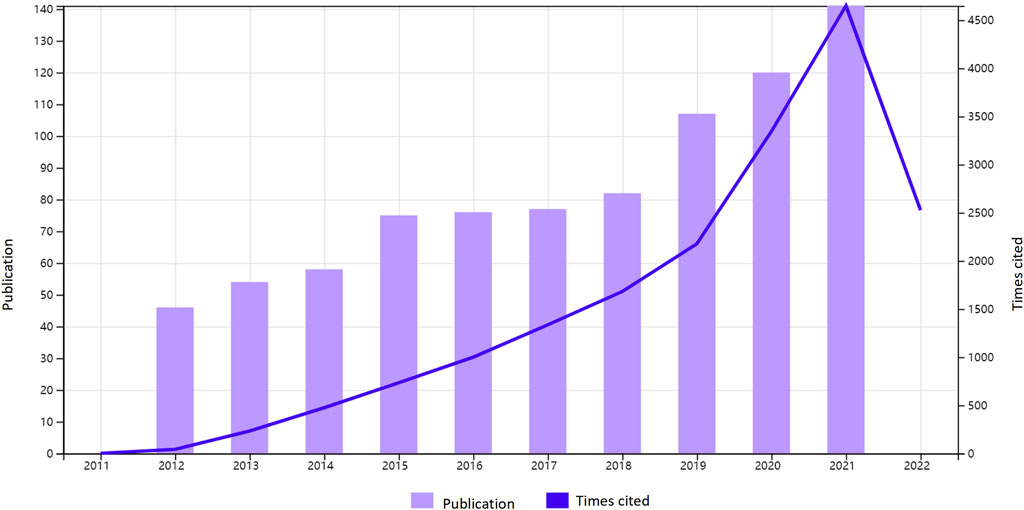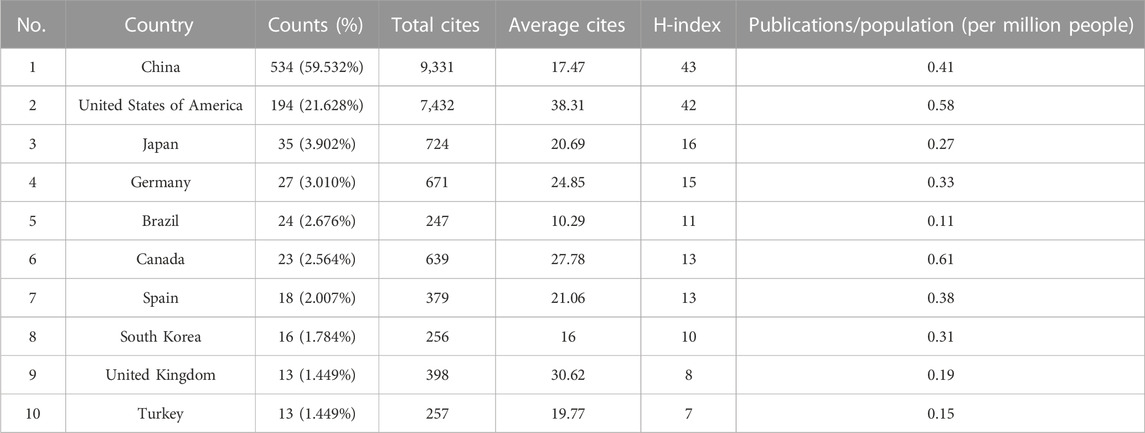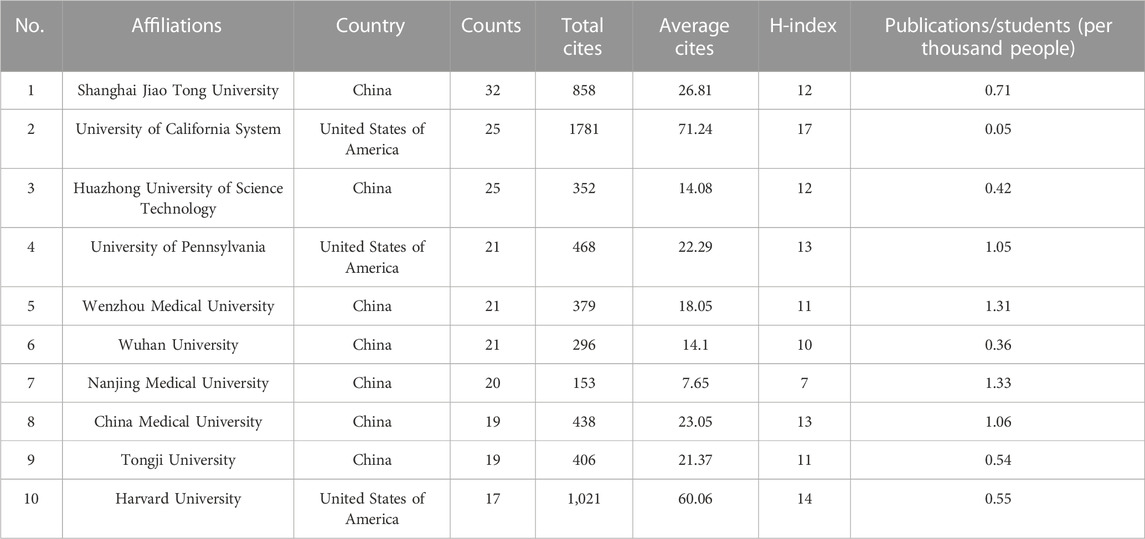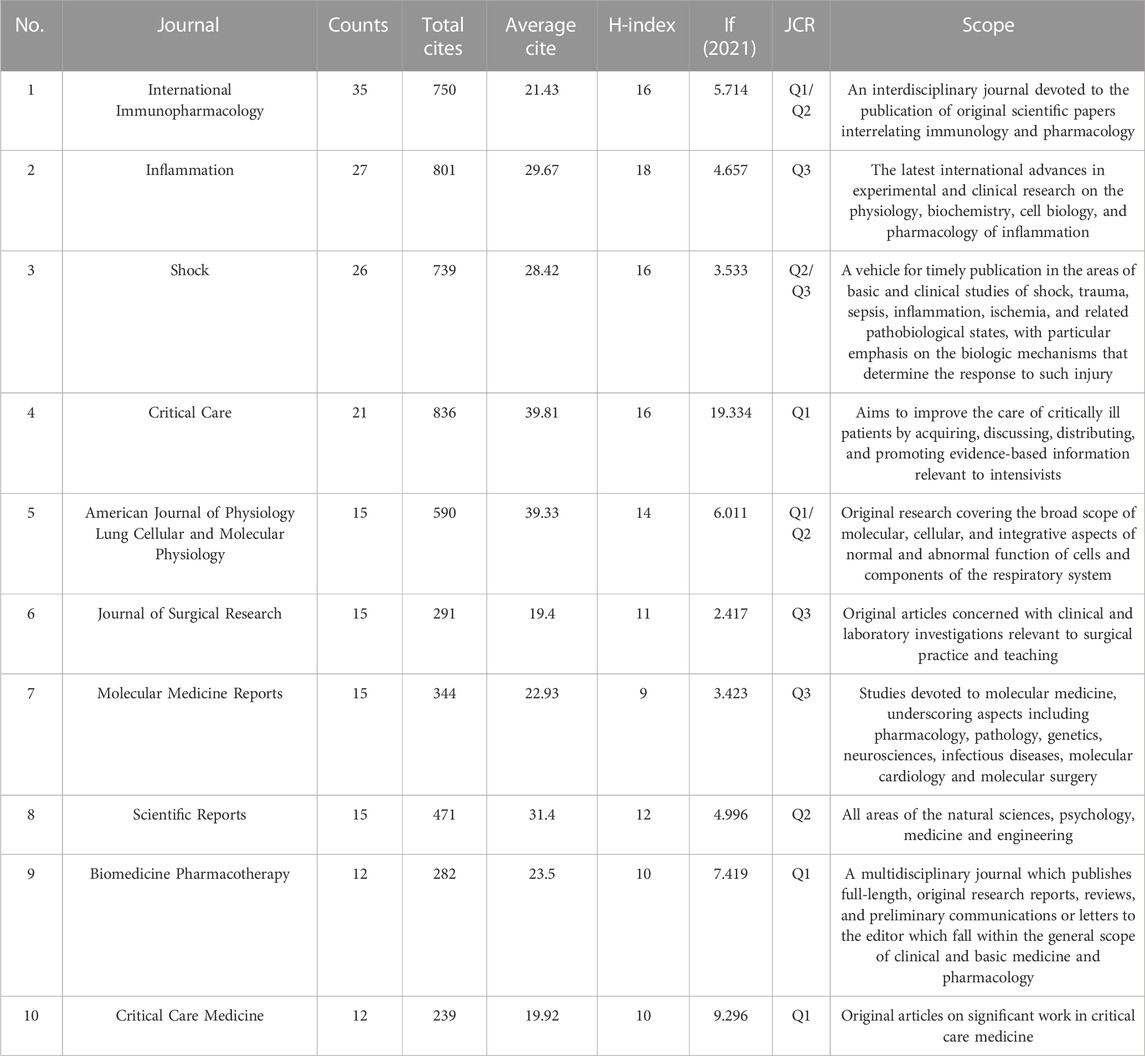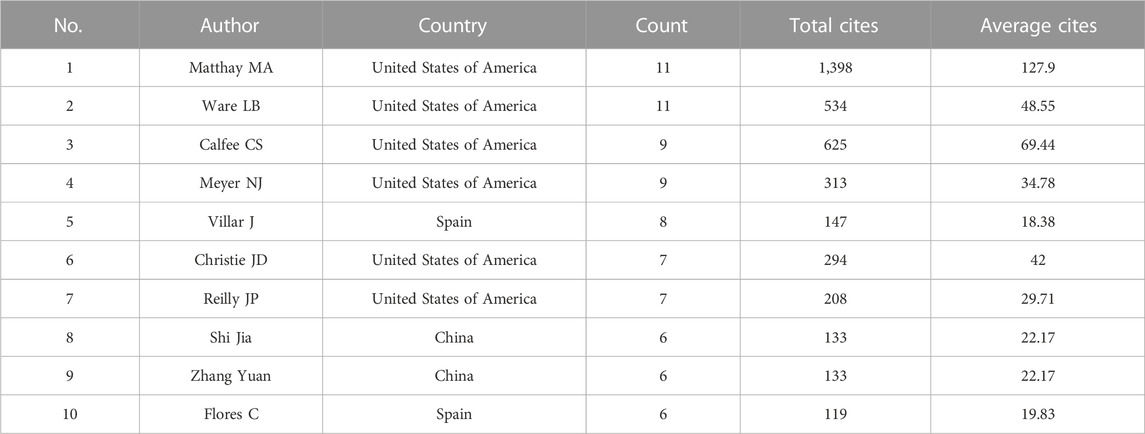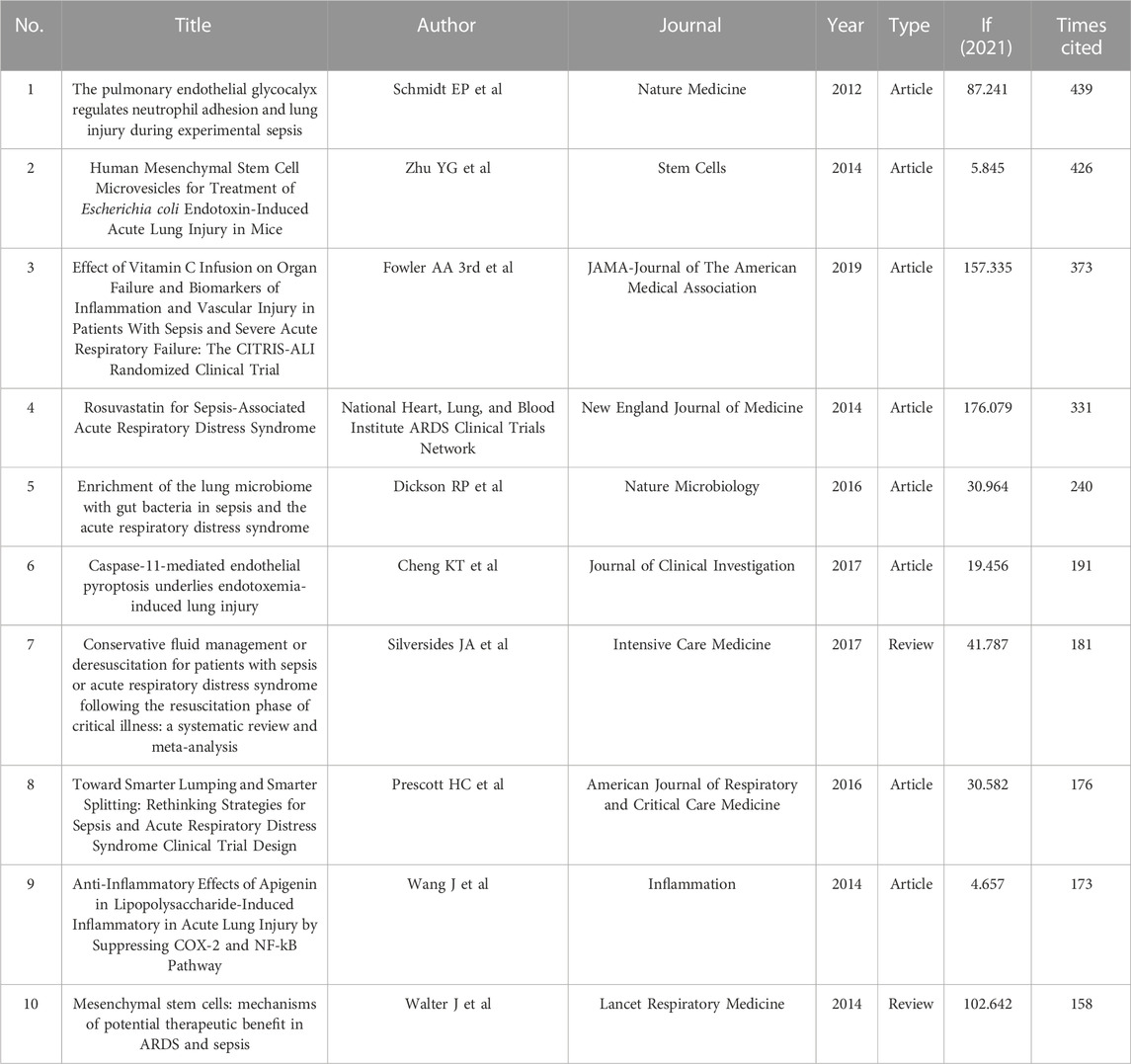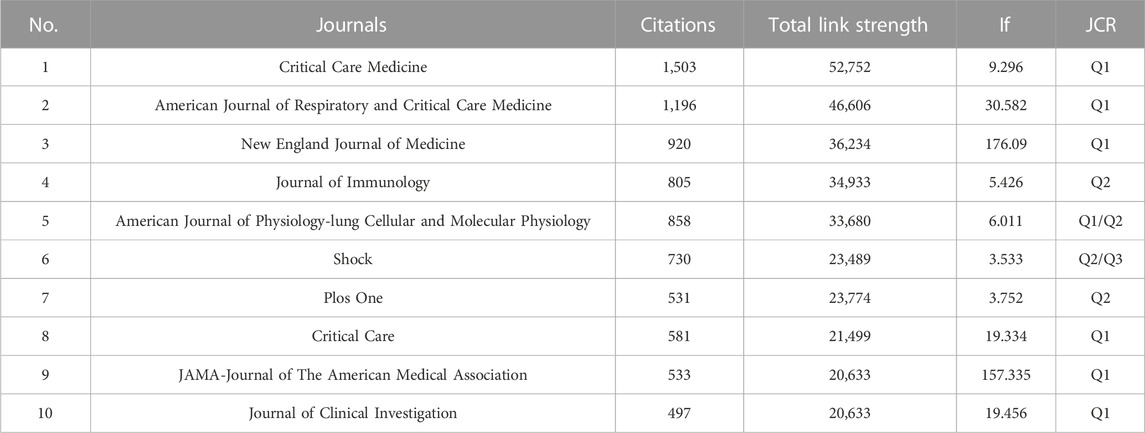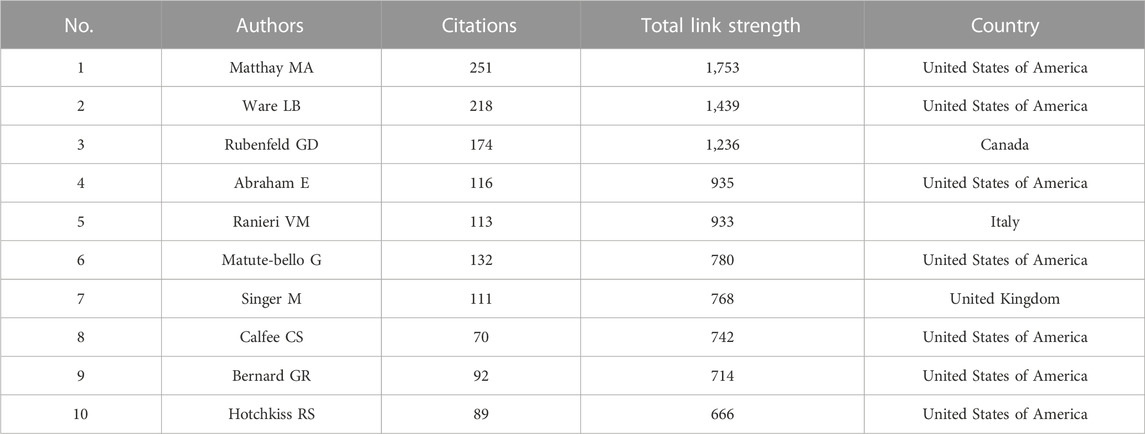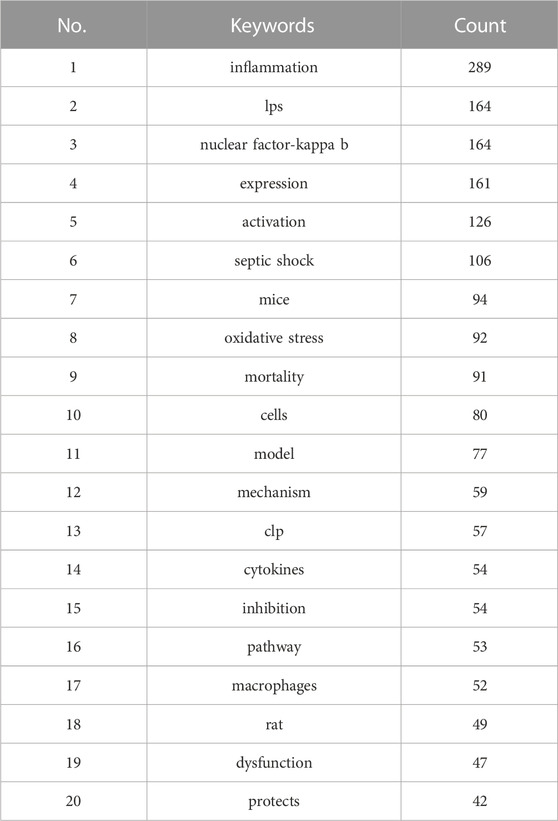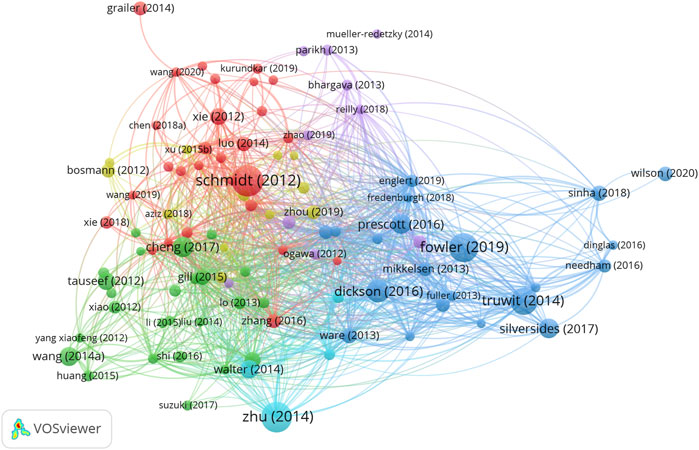- Department of Critical Care Medicine, The Third Xiangya Hospital, Central South University, Changsha, Hunan, China
Background: Sepsis associated with acute lung injury (ALI) is a common acute and severe disease with severe socioeconomic burden. The aim of this study is to explore the literatures of sepsis associated with ALI from a bibliometric perspective.
Methods: Articles and reviews related to sepsis associated with ALI published from 2012 to 2021 in the Web of Science Core Collection were retrieved. Countries, affiliations, journals, authors, references, co-citation and keyword analysis in this field were visually analyzed using WOS citation reports, bibliometric.com, CtieSpace and VOSviewer software.
Results: Over the last decade (2012–2021), marked progress has been made in the area of sepsis associated with ALI research. 836 papers were enrolled in this study. China accounts for the most contributors. Articles from the United States has the highest average cited. Shanghai Jiao Tong University, University of California System and Huazhong University of Science Technology were the main contributing institutions. Articles in International Immunopharmacology, Inflammation, Shock and Critical Care were cited the most. Matthay MA and Ware LB were the main contributors to this field. Inflammation and NF-κB have always been the focus of sepsis associated with ALI related research, and programmed cell death (including apoptosis, necroptosis and pyroptosis) may be the important direction of future research.
Conclusion: Research on the sepsis associated with ALI is flourishing. The research on programmed cell death is a hot spot and may be a promising research field in the coming years.
1 Introduction
Sepsis is a life-threatening organ dysfunction caused by the dysregulation of the body’s response to infection (Singer et al., 2016). The global study of adult sepsis hospitalized patients showed that the overall mortality rate of sepsis patients was 26.7%, while the mortality rate of sepsis patients in intensive care unit (ICU) was 41.9% (Fleischmann-Struzek et al., 2020). According to studies in China, the annual medical cost of 230,000 septic patients treated in ICU is about $4.6 billion (Xie et al., 2020). Sepsis has become an important global public health problem. Acute lung injury (ALI) is one of the most common complications of sepsis. Study has shown that 6%–42% of ALI is caused by sepsis (Sessler et al., 1996). ALI caused by sepsis refers to acute hypoxic respiratory failure caused by sepsis, which is secondary to alveolar injury caused by dysregulation of inflammatory response. The pathophysiology of ALI is mainly manifested by severe inflammatory injury of alveolar capillary barrier, depletion of pulmonary surfactant, reduction of effective ventilation lung tissue, and reduction of lung compliance (Ranieri et al., 2012; Matthay et al., 2019). Since ALI was first described in 1967, people’s understanding and definition of its clinicopathology have been constantly updated. Nowadays, the clinical diagnosis and treatment of ALI have always followed the Berlin definition in 2012 (Ranieri et al., 2012). Since ALI is a complex and clinically heterogeneous syndrome, the effective treatment strategies that can reach consensus today are limited to protective ventilation therapy (auxiliary neuromuscular blockers and prone ventilation), while other anti-inflammatory drugs [e.g., glucocorticoids, macrophage colony stimulating factor (GM-CSF), statins, aspirin] and drugs to improve lung function (β receptor agonists, nitric oxide inhalation) did not significantly reduce the mortality of ALI (Bellani et al., 2016). ALI associated with sepsis involves multiple molecular mechanisms. Consequently, it is significant to quantitatively analyze the status quo, focus areas, and future prospects related to ALI associated with sepsis.
Bibliometrics is an interdisciplinary science that uses mathematical and statistical methods to study literature and bibliometrics features (Wu et al., 2022). Bibliometrics uses mathematical methods to break through the limitations of time and space, so that researchers can fully understand the current situation, hot spots and trends of a research field. Currently, bibliometric analysis has been used in many fields, including atherosclerosis, Parkinson’s disease, gout and liver transplantation (Jiang et al., 2022; Li et al., 2022; Wang et al., 2022; Wen et al., 2022). To date, there is no literature about bibliometrics analysis of sepsis associated with ALI. To fill this gap, this study analyzed the characteristics and trends of publications related to sepsis associated with ALI through bibliometrics.
2 Materials and methods
2.1 Data sources and search strategy
The search was conducted using the Web of Science (WOS) Core Collection database. All the literature was retrieved in WOS. The search terms were TS= (sepsis OR endotoxemia) AND TS= ((acute lung injury) OR (ALI) OR (acute respiratory distress syndrome) OR (respiratory distress syndrome) OR (ARDS)). The language is limited to English, and the document types are limited to article or review. For the time span, we chose the 10 years between 2012 and 2021. In total, 4,790 articles were initially identified in our study. Two reviewers independently screened the titles and abstracts to exclude literature which unrelated to sepsis associated with ALI. After the full-text reading, 836 articles that exclusively addressed the topic of sepsis associated with ALI were included. Since the data of this study is from WOS, which is an open database, there are no ethical issues related to access in this study.
2.2 Bibliometric analyzing
“Citation Report” function of the web science was employed to evaluate the citation rates and the H-index. The “bibliometric.com” is a website for online bibliometric analysis (https://bibliometric.com/). CiteSpace (Vesion 5.8) is a widely used visual analysis software (Chen, 2004). VOSviewer (Vesion 1.16.18) is a software for plotting maps based on network data (van Eck and Waltman, 2010). We used WOS citation reports, bibliometric.com, CtieSpace and VOSviewer software for bibliometric analysis. Detailed procedures of the enrolment and analysis are illustrated in Figure 1.
3 Results
3.1 The research trends
We collected 836 publications from the Web of Science core collection published in 312 journals over the period 2012–2021. The number of publications related to sepsis associated with ALI by year was presented in Figure 2. In total, 836 publications have been cited 13,491 times, and the average number of citations per publication is 21.76 times.
3.2 Analysis of the top 10 countries
The top 10 most productive countries were shown in Table 1. Table 1 shows the total citations, average number of citations per publication, H-index and publications/population (per million people) of the top 10 countries. Among the top 10 countries, China ranked first in the sum of total publications (534), cited times (9,331) and H-index (43), but only ranked seventh in the average cited times of a single article (17.47). In terms of the total publications, the United States ranked second. However, the United States ranked first in the average number of citations per publication (38.31). It was followed by Japan, Germany, Brazil, Canada, Spain, South Korea, United Kingdom and Turkey. Canada ranked first in publications/population (per million people) (0.61). Figure 3A showed the total of publications by each country each year, and Figure 3B showed the cooperative relationship between each country. The results showed the greatest cooperation between China and the United States, and the United States cooperated with other countries more broadly.
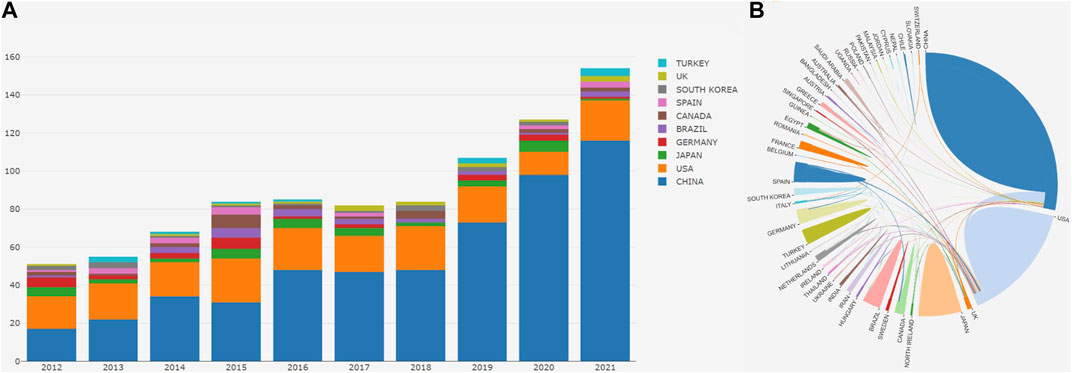
FIGURE 3. The number of publications by country (A) The total of publications by each country each year; (B) The cooperative relationship between each country.
3.3 Analysis of the top 10 affiliations
The top 10 productive affiliations were shown in Table 2. Shanghai Jiao Tong University had the highest the sum of total publications (32), followed by University of California System (25), Huazhong University of Science Technology (25), University of Pennsylvania (21), Wenzhou Medical University (21), Wuhan University (21), Nanjing Medical University (20), China Medical University (19), Tongji University (19) and Harvard University (17). University of California System ranked first in terms of the average number of citations per publication (71.24), the highest cited times (1,781) and H-index (17). Nanjing Medical University ranked first in publications/students (per thousand people) (1.33). Although the total publications of Nanjing Medical University in China were relatively high, their average number of citations per publication was far behind other high-yield universities. It may be related to the low quality of the published articles and the relatively obscure journals.
3.4 Analysis of the top 10 journals
The top 10 most active journals were shown in Table 3. International Immunopharmacology (IF = 5.714, 2021) was the most active journal in sepsis associated with ALI research, with 35 articles, followed by Inflammation (IF = 4.657, 2021), with 27 articles; Shock (IF = 3.533, 2021), with 26 articles; Critical Care (IF = 19.334, 2021), with 21 articles; American Journal of Physiology Lung Cellular and Molecular Physiology (IF = 6.011, 2021), with 15 articles; Journal of Surgical Research (IF = 2.417, 2021), with 15 articles; Molecular Medicine Reports (IF = 3.423, 2021), with 15 articles; Scientific Reports (IF = 4.996, 2021), with 15 articles; Biomedicine Pharmacotherapy (IF = 7.419, 2021), with 12 articles and Critical Care Medicine (IF = 9.296, 2021), with 12 articles. Among the top 10 journals, International Immunopharmacology published the most sepsis associated with ALI related articles. International Immunopharmacology was an interdisciplinary journal devoted to the publication of original scientific papers interrelating immunology and pharmacology. Additionally, Critical Care (836 citations) had the most total citations. Inflammation (H-index of 18) ranked first in H-index. Critical Care aimed to improve the care of critically ill patients by acquiring, discussing, distributing, and promoting evidence-based information relevant to intensivists. In addition, American Journal of Physiology Lung Cellular and Molecular Physiology had relatively high average number of citations per publication (39.33 average citations). The American Journal of Physiology Lung Cellular and Molecular Physiology published original research covering the broad scope of molecular, cellular, and integrative aspects of normal and abnormal function of cells and components of the respiratory system.
3.5 Analysis of the top 10 authors
The top 10 authors with the most publications were shown in Table 4. 4,366 authors contributed to sepsis associated with ALI related publications. Matthay MA was the most productive which published 11 articles (1,398 citations and 127.9 average citations), followed by Ware LB (11 articles, 534 citations and 48.55 average citations), Calfee, CS (9 articles, 625 citations and 69.44 average citations), Meyer, NJ (9 articles, 313 citations and 34.78 average citations), Villar, J (8 articles, 147 citations and 18.38 average citations), Christie, JD (7 articles, 294 citations and 42 average citations), Reilly, JP (7 articles, 208 citations and 29.71 average citations), Shi Jia (6 articles, 133 citations and 22.17 average citations), Zhang Yuan (6 articles, 133 citations and 22.17 average citations) and Flores, C (6 articles, 119 citations and 19.83 average citations). In addition, most of the top 10 authors were from the United States of America (6), China (2) or Spain (2).
3.6 Analysis of the top 10 most cited publications
Table 5 shows the 10 most cited articles, and the range of citations was from 158 to 439. “The pulmonary endothelial glycocalyx regulates neutrophil adhesion and lung injury during experimental sepsis (Schmidt et al., 2012)” published by Schmidt EP et al. (2012) and had 439 citations; “Human Mesenchymal Stem Cell Microvesicles for Treatment of Escherichia coli Endotoxin-Induced Acute Lung Injury in Mice (Zhu et al., 2014)”, published by Zhu YG et al. (2014), which was with 426 citations; and the third with 373 citations was the “Effect of Vitamin C Infusion on Organ Failure and Biomarkers of Inflammation and Vascular Injury in Patients With Sepsis and Severe Acute Respiratory Failure: The CITRIS-ALI Randomized Clinical Trial (Fowler et al., 2019)” published by Fowler AA third. et al. (2019).
3.7 Co-citation analysis
3.7.1 Journals
Figure 4 shows the relationship between 288 identified journals (the minimum number of citations of journals exceeds 20) and the total link strength using VOSviewer. As presented in Table 6, the top 10 journals by total link strength were as follows: Critical Care Medicine (total link strength = 52,752 times), American Journal of Respiratory and Critical Care Medicine (46,606 times), New England Journal of Medicine (6,234 times), Journal of immunology (34,933 times), American Journal of Physiology-lung Cellular and Molecular Physiology (33,680 times), Shock (25,489 times), Plos One (23,774 times), Critical Care (21,499 times), JAMA (20,633 times) and Journal of Clinical Investigation (20,633 times). Therefore, Critical Care Medicine was the predominant journal in sepsis associated with ALI globally according to co-citation analysis.
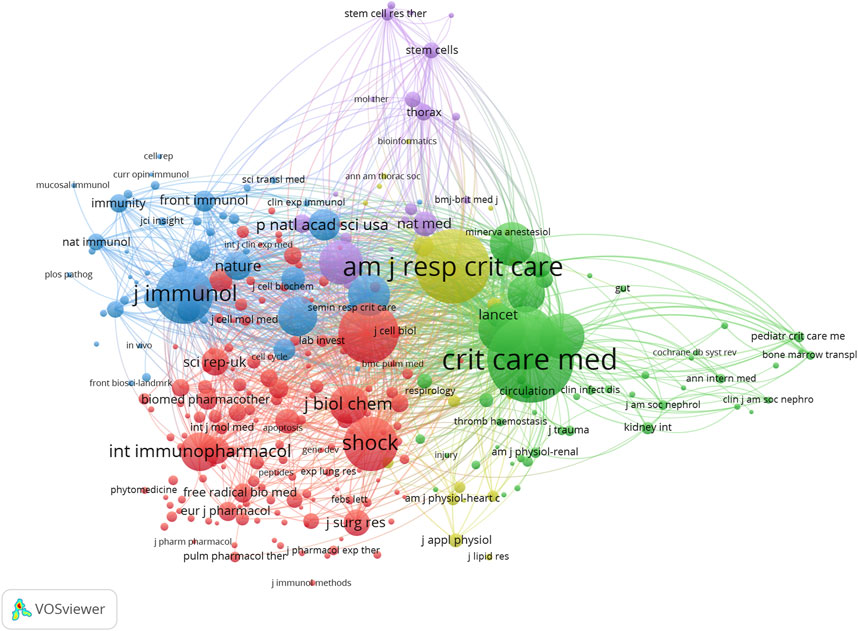
FIGURE 4. The mapping on journals of sepsis associated with ALI. The relationship between 288 identified journals (the minimum number of citations of journals exceeds 20) and the total link strength.
3.7.2 Authors
Figure 5 shows the relationship between 179 identified authors (the minimum number of citations of journals exceeds 15) and the total link strength using VOSviewer. As presented in Table 7, the top 10 authors by total link strength were as follows: Matthay MA (total link strength = 1,753 times), Ware LB (1,439 times), Rubenfeld GD (1,239 times), Abraham E (935 times), Ranieri VM (933 times), Matute-Bello G (780 times), Singer M (768 times), Calfee CS (742 times), Bernard GR (714 times) and Hotchkiss RS (666 times). Therefore, Matthay MA was the predominant author in sepsis associated with ALI globally according to co-citation analysis.
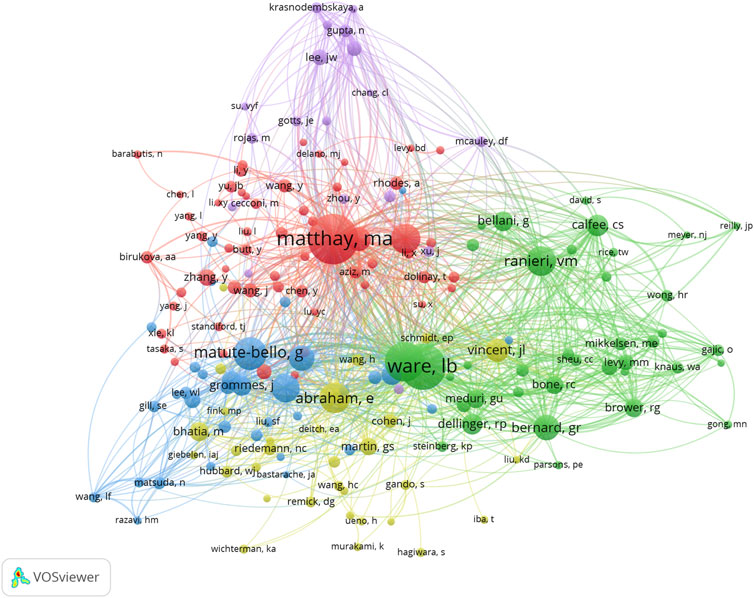
FIGURE 5. The mapping on authors of sepsis associated with ALI. The relationship between 179 identified authors (the minimum number of citations of journals exceeds 15) and the total link strength.
3.7.3 References
Figure 6 shows the relationship between 193 identified references (the minimum number of citations of journals exceeds 10) and the total link strength using VOSviewer. As presented in Table 8, the top 10 references by total link strength were as follows: Rubenfeld GD, “Incidence and outcomes of acute lung injury (Rubenfeld et al., 2005)”, New England Journal of Medicine, 2005 (total link strength = 932 times). Ware LB, “The acute respiratory distress syndrome (Ware and Matthay, 2000)”, New England Journal of Medicine, 2000 (602 times). Ranieri VM, “Acute respiratory distress syndrome: the Berlin Definition (Ranieri et al., 2012)”, JAMA, 2012 (581 times). Singer M, “The Third International Consensus Definitions for Sepsis and Septic Shock (Sepsis-3) (Singer et al., 2016)”, JAMA, 2016 (579 times). Matthay MA, “The acute respiratory distress syndrome (Matthay et al., 2012)”, Journal of Clinical Investigation, 2012 (495 times). Grommes J, “Contribution of neutrophils to acute lung injury (Grommes and Soehnlein, 2011)”, Molecular Medicine, 2011 (395 times). Rittirsch D, “Immunodesign of experimental sepsis by cecal ligation and puncture (Rittirsch et al., 2009)”, Nature Protocols, 2009 (381 times). Matute-Bello G, “Animal models of acute lung injury (Matute-Bello et al., 2008)”, American Journal of Physiology-Lung Cellular, 2008 (364 times). Bellani G, “Epidemiology, Patterns of Care, and Mortality for Patients With Acute Respiratory Distress Syndrome in Intensive Care Units in 50 Countries (Bellani et al., 2016)”, JAMA, 2016 (338 times) and Bernard G, “The American-European Consensus Conference on ARDS. Definitions, mechanisms, relevant outcomes, and clinical trial coordination (Bernard et al., 1994)”, American Journal of Respiratory and Critical Care Medicine, 1994 (320 times). Therefore, “Incidence and outcomes of acute lung injury (Rubenfeld et al., 2005)” was the predominant reference in sepsis associated with ALI globally according to co-citation analysis. The authors of this literature conducted a prospective, population-based cohort study at 21 hospitals using a validated screening protocol to identify patients meeting consensus criteria for ALI.
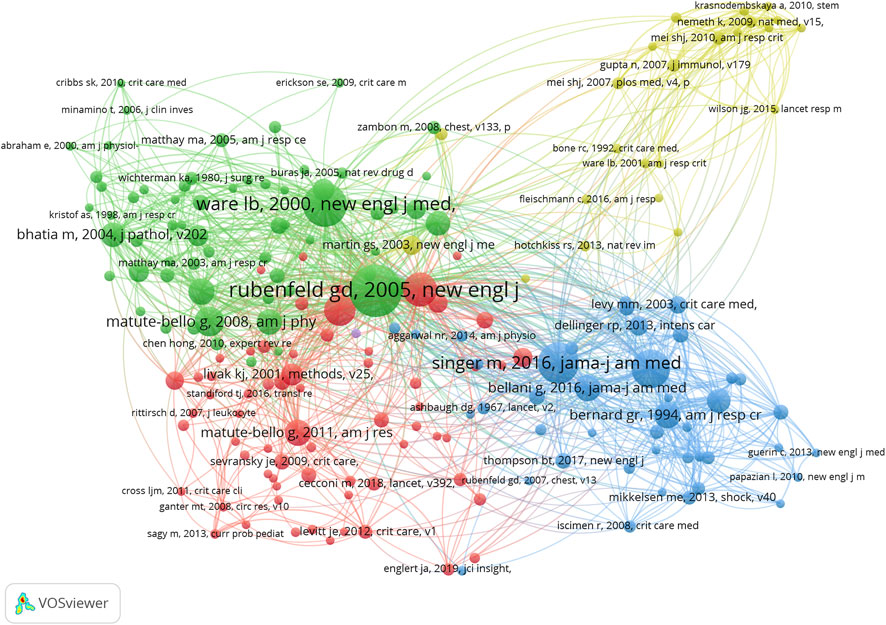
FIGURE 6. The mapping on references of sepsis associated with ALI. The relationship between 193 identified references (the minimum number of citations of journals exceeds 10) and the total link strength.
3.8 The analysis of keywords
Keywords usually reflect the theme of research, and systematic analysis of keywords reflect the research hotspot in a specific field. When analyzing the keywords, we combined some different versions of the same terms, including different spelling versions (e.g., “nf-kappa-b”, “nuclear factor-kappa b” and “NF-κB”), and abbreviated terms (e.g., “LPS” and “lipopolysaccharide”). Table 9 shows the top 20 keywords, with most of them falling into two groups. One group is mechanisms involved in sepsis associated with ALI, such as inflammation, NF-κB, cytokines and oxidative stress. The other group is research methods involved in sepsis associated with ALI, including keywords like LPS (lipopolysaccharide), CLP (cecal ligation and puncture), and macrophages. In Figure 7A, we used VOSviewer software to show the primary keywords more compact. As presented in Figure 7B, the blue keywords appeared earlier, while the yellow keywords appeared later. The results of co-occurrence analysis indicated that programmed cell death (PCD) might become the hot spot of future sepsis associated with ALI research. The evolution of a knowledge domain can be represented by citation bursts. Citation burst refers to the literature that has attracted the attention of scholars in a specific field during a specific period of time. CiteSpace has a burst detection function, which we use to find the top 25 terms with the most cited bursts (Figure 7C). Keywords related to ALI, such as nitric oxide synthase, pneumonia, and interleukin-6, began to burst at an early stage. Subsequently, keywords such as mechanical ventilation began to burst, indicating that the focus of the study has shifted to the treatment of ALI. It is also noteworthy that TLR4 and NF-κB only had bursts recently.
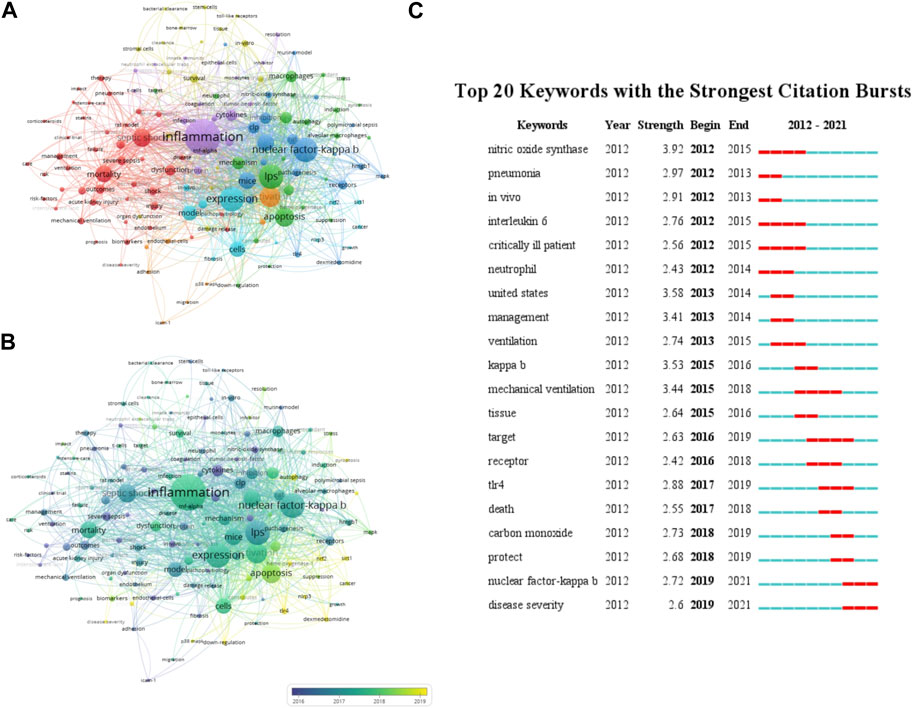
FIGURE 7. The mapping on keywords of sepsis associated with ALI (A) Visualization of 151 identified keywords in sepsis associated with ALI; (B) Overlay visualization of the 151 identified keywords in sepsis associated with ALI based on the average time they appeared in the publications. The blue keyword appeared earlier, while the yellow keyword appeared later. (C) The top 25 terms with the most cited bursts.
4 Discussion
Bibliometrics plays a very important role in improving the ability of literature retrieval and utilization, helping beginners to rapidly enter a particular field. For the first time, we reported the bibliometric analysis to review the progress of sepsis associated with ALI related research in worldwide in the past decade. At present, research on the sepsis associated with ALI is flourishing. In the initial phase, the definition of ALI and diagnostic criteria predominated and, nowadays, the focus of interest is on understanding the pathophysiological mechanisms that lead to apoptosis, necroptosis and pyroptosis. The research on programmed cell death is a hot spot and may be a promising research field in the coming years.
Among the top 10 countries, China ranked first in the total number of publications, cited times and H-index, which indicated that China is a high-yield country in the study of sepsis associated with ALI, and the United States ranked first in average number of citations per publication, which means that the United States has more influence in this field. Seven Chinese affiliations came in the top 10 affiliations in the research of sepsis associated with ALI, the United States affiliations only three came in the top 10 affiliations, but the United States affiliations had a relatively high cited times, average number of citations per publication and H-index. Among the top journals, International Immunopharmacology ranked first in the sum of total publications, Inflammation first in H-index, Critical Care ranked first in cited times, average number of citations per publication and IF. Six authors of the United States came in the top 10 authors in the research of sepsis associated with ALI, Chinese and Spain each have two authors came in the top 10 authors. Matthay MA has published the most papers. His important contribution to this field is he screened a number of markers and therapeutic targets related to sepsis associated with ALI through clinical and basic research. Although China ranked first in the sum of total publications, only two authors have come in the top 10 authors in the world, indicating that China still needs to increase investment in this field to lead the research trend. Among the top 10 most cited publications, “The pulmonary endothelial glycocalyx regulates neutrophil adhesion and lung injury during experimental sepsis” ranked first, which was published in Nature Medicine in 2012 and has been cited 439 times in total. The article found that heparinase inhibition could alleviating sepsis-induced ALI and mortality in mice. From the perspective of co-cited journals, Critical Care Medicine had been the most co-cited journal. From the perspective of co-cited authors, Matthay MA had been the most co-cited author. Among the 24,236 co-cited references retrieved, Table 8 shows the top 10 references by total link strength, of which “Incidence and outcomes of acute lung injury” is the most frequently cited.
In the results, a systematic bibliometric analysis has been conducted on the studies on sepsis associated with ALI published in WOS from 2012 to 2021. Table 9 shows the top 20 keywords, with most of them falling into two groups. One group is mechanisms involved in sepsis associated with ALI, such as inflammation, NF-κB, oxidative stress and cytokines. The other group is research methods involved in sepsis associated with ALI, including keywords like LPS, CLP, and macrophages. NF-κB is an important nuclear transcription factor in cells. It is related to the inflammatory changes of many human diseases, such as ALI, rheumatoid arthritis, heart and brain diseases (Gong et al., 2021; Jiao et al., 2021; Wang et al., 2021; Xie et al., 2022). Many studies have demonstrated that NF-κB pathways are involved in sepsis associated with ALI (Wang et al., 2014; Li et al., 2016; Wang et al., 2020; Du et al., 2021). There are five members of NF-κB family, including RelA (p65), RelB, NF-κB1 (P50), NF-κB2 (P52) and c-Rel (Jimi and Katagiri, 2022). Commonly referred to as NF-κB protein, it refers to NF-κB1 dimer protein formed by P65/p50 subunit. The classical NF-κB pathway can be activated by various stimuli (e.g., TNF-α, LPS, IL-1β). It is mediated by cell surface receptors, such as TLR, TNF-R and antigen receptors, and activated by various adaptor proteins and signaling kinase IKK (including IKKα, IKKβ and IKKγ). Activation of the IKK complex leads to phosphorylation of the NF-κB inhibitor protein IκBα, which ultimately leads to proteasome degradation and release and translocation of NF-κB dimers, such as p50-RelA (p65), to the nucleus to drive transcription of target genes. The activation of immune response genes ultimately leads to sepsis associated with ALI (Figure 8).
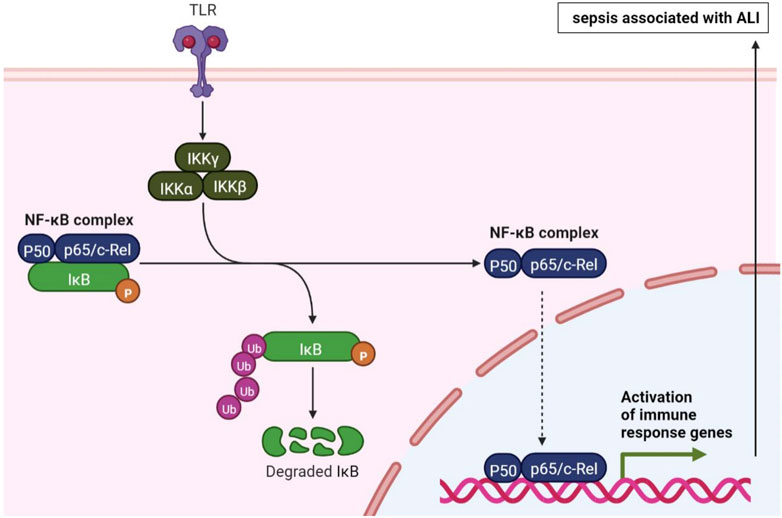
FIGURE 8. The mechanism of NF-κB in sepsis associated with ALI (Created with BioRender.com).
The results of co-occurrence analysis suggested that PCD might become a research hotspot of sepsis associated with ALI in the future, and before 2017, most studies focused on the study of complications and inflammation. PCD is a genetically regulated process leading to the death of cells. It plays a critical role in organismal development, homeostasis, and pathogenesis (Liang and He, 2022). At present, it is found that besides apoptosis, PCD also includes necroptosis and pyroptosis. According to our study, PCD has been extensively involved in sepsis associated with ALI studies in recent years.
It is important to clarify the future research direction of sepsis associated with ALI. Therefore, the recent articles with high citation rate should be divided into subgroups to analyze their research hotspots. As presented in Figure 9, the top 100 cited articles were used for bibliographic coupling and divided into 6 clusters according to the research direction. Cluster #1 contains 28 articles, the main research topic is the effect of different drugs on sepsis associated with ALI. Schmidt EP et al., in 2012 found that heparanase inhibition prevented endotoxemia-associated glycocalyx loss and neutrophil adhesion and, accordingly, attenuated sepsis-induced ALI and mortality in mice. Cluster #2 contains 25 articles, the main research topic is the pathogenesis of sepsis associated with ALI. Cheng KT et al., in 2017 discovered that caspase-11-mediated endothelial pyroptosis underlies sepsis-induced ALI (Cheng et al., 2017). Toll-like receptor 4 (TLR4) activation of TRPC6-dependent calcium signaling mediates endotoxin-induced lung vascular permeability and inflammation (Tauseef et al., 2012). Cluster #3 contains 21 articles, the main research topic is clinical study of sepsis associated with ALI. In CITRIS-ALI randomized clinical trial, a 96-h infusion of vitamin C compared with placebo did not significantly improve organ dysfunction scores or alter markers of inflammation and vascular injury (Fowler et al., 2019). Many common drugs, including statins (Mansur et al., 2015; Dinglas et al., 2016; Needham et al., 2016), hydrocortisone (Tongyoo et al., 2016), carbon monoxide (Fredenburgh et al., 2018) and aspirin (Toner et al., 2015), have been tested in clinical trials for the treatment of sepsis-induced ALI. Cluster #4 contains 12 articles, the main research topic is the role of intracellular substances in sepsis associated with ALI. Zhou et al., in 2019 demonstrated that human endothelial progenitor cell (EPC) exosomes are beneficial in LPS-induced ALI mice (Zhou et al., 2019). Jiang J et al. identified that targeting NOX4 may be an innovative therapeutic option that is markedly effective in treating sepsis-induced ALI (Jiang et al., 2020). Cluster #5 contains 10 articles, the main research topic is markers and therapeutic targets of sepsis associated with ALI. Reilly JP et al. found that plasma angiopoietin-2 as a potential causal marker in sepsis-associated ALI development (Reilly et al., 2018). Cluster #6 contains 4 articles, the main research topic is application of mesenchymal stem cells (MSC) in sepsis associated with ALI. Human MSC-derived microvesicles were therapeutically effective following E. coli sepsis-induced ALI in mice (Zhu et al., 2014).
5 Limitations
There are some limitations in the present study. First of all, we chose WOS as the only literature search database, which may have missed some publications, resulting in database bias. Second, only literatures published during 2012–2021 were included, articles published before were missed. Finally, some of the latest high-quality articles may not be enrolled in top 10 journals and top 10 most cited publications due to the low number of citations. However, we believe that this work can still be used to present the overall situation and trends in this field.
6 Conclusion
China is a major producing country, and the United States has more influence in this field. Shanghai Jiao Tong University, University of California System and Huazhong University of Science Technology were the main contributing institutions to sepsis associated with ALI. International Immunopharmacology, Inflammation, Shock and Critical Care have published the latest studies and novel progress in this field. Matthay MA and Ware LB were the main contributors to this field. Inflammation and NF-κB have always been the focus of sepsis associated with ALI related research, and PCD (including apoptosis, necroptosis and pyroptosis) may be the important direction of future research. Overall, our study will provide useful reference for further research on sepsis associated with ALI.
Data availability statement
The raw data supporting the conclusions of this article will be made available by the authors, without undue reservation.
Author contributions
GL conceived the study, data analysis, and drafted the manuscript. WW conceived the study, data analysis. ZH conceived the study, its design and critically revised the manuscript. All authors contributed to the article and approved the submitted version.
Funding
The work was supported by the Natural Science Foundation of Hunan Province (2021JJ31005) and the National Natural Science Foundation of China (no: 82272216).
Conflict of interest
The authors declare that the research was conducted in the absence of any commercial or financial relationships that could be construed as a potential conflict of interest.
Publisher’s note
All claims expressed in this article are solely those of the authors and do not necessarily represent those of their affiliated organizations, or those of the publisher, the editors and the reviewers. Any product that may be evaluated in this article, or claim that may be made by its manufacturer, is not guaranteed or endorsed by the publisher.
References
Bellani, G., Laffey, J. G., Pham, T., Fan, E., Brochard, L., Esteban, A., et al. (2016). Epidemiology, Patterns of care, and mortality for patients with acute respiratory distress syndrome in intensive care units in 50 countries. Jama 315 (8), 788–800. doi:10.1001/jama.2016.0291
Bernard, G. R., Artigas, A., Brigham, K. L., Carlet, J., Falke, K., Hudson, L., et al. (1994). The American-European Consensus Conference on ARDS. Definitions, mechanisms, relevant outcomes, and clinical trial coordination. Am. J. Respir. Crit. Care Med. 149 (3), 818–824. doi:10.1164/ajrccm.149.3.7509706
Chen, C. (2004). Searching for intellectual turning points: Progressive knowledge domain visualization. Proc. Natl. Acad. Sci. U. S. A. 101 (1), 5303–5310. doi:10.1073/pnas.0307513100
Cheng, K. T., Xiong, S., Ye, Z., Hong, Z., Di, A., Tsang, K. M., et al. (2017). Caspase-11-mediated endothelial pyroptosis underlies endotoxemia-induced lung injury. J. Clin. investigation 127 (11), 4124–4135. doi:10.1172/JCI94495
Dinglas, V. D., Hopkins, R. O., Wozniak, A. W., Hough, C. L., Morris, P. E., Jackson, J. C., et al. (2016). One-year outcomes of rosuvastatin versus placebo in sepsis-associated acute respiratory distress syndrome: Prospective follow-up of SAILS randomised trial. Thorax 71 (5), 401–410. doi:10.1136/thoraxjnl-2015-208017
Du, Y., Zhang, H., Guo, Y., Song, K., Zeng, L., Chen, Y., et al. (2021). CD38 deficiency up-regulated IL-1β and MCP-1 through TLR4/ERK/NF-κB pathway in sepsis pulmonary injury. Microbes Infect. 23 (9-10), 104845. doi:10.1016/j.micinf.2021.104845
Fleischmann-Struzek, C., Mellhammar, L., Rose, N., Cassini, A., Rudd, K. E., Schlattmann, P., et al. (2020). Incidence and mortality of hospital- and ICU-treated sepsis: Results from an updated and expanded systematic review and meta-analysis. Intensive care Med. 46 (8), 1552–1562. doi:10.1007/s00134-020-06151-x
Fowler, A. A., Truwit, J. D., Hite, R. D., Morris, P. E., DeWilde, C., Priday, A., et al. (2019). Effect of vitamin C infusion on organ failure and Biomarkers of inflammation and vascular injury in patients with sepsis and severe acute respiratory failure: The CITRIS-ALI randomized clinical trial. Jama 322 (13), 1261–1270. doi:10.1001/jama.2019.11825
Fredenburgh, L. E., Perrella, M. A., Barragan-Bradford, D., Hess, D. R., Peters, E., Welty-Wolf, K. E., et al. (2018). A phase I trial of low-dose inhaled carbon monoxide in sepsis-induced ARDS. JCI insight 3 (23), e124039. doi:10.1172/jci.insight.124039
Gong, F., Li, R., Zheng, X., Chen, W., Zheng, Y., Yang, Z., et al. (2021). OLFM4 regulates lung epithelial cell function in sepsis-associated ARDS/ALI via LDHA-mediated NF-κB signaling. J. Inflamm. Res. 14, 7035–7051. doi:10.2147/JIR.S335915
Grommes, J., and Soehnlein, O. (2011). Contribution of neutrophils to acute lung injury. Mol. Med. Camb. Mass) 17 (3-4), 293–307. doi:10.2119/molmed.2010.00138
Jiang, D., Ji, T., Liu, W., Bednarsch, J., Selzner, M., Pratschke, J., et al. (2022). Four decades of clinical liver transplantation research: Results of a comprehensive bibliometric analysis. Transplantation 106, 1897–1908. doi:10.1097/TP.0000000000004224
Jiang, J., Huang, K., Xu, S., Garcia, J. G. N., Wang, C., and Cai, H. (2020). Targeting NOX4 alleviates sepsis-induced acute lung injury via attenuation of redox-sensitive activation of CaMKII/ERK1/2/MLCK and endothelial cell barrier dysfunction. Redox Biol. 36, 101638. doi:10.1016/j.redox.2020.101638
Jiao, D., Liu, Y., Hou, T., Xu, H., Wang, X., Shi, Q., et al. (2021). Notoginsenoside R1 (NG-R1) promoted lymphatic drainage function to ameliorating rheumatoid arthritis in TNF-tg mice by suppressing NF-κB signaling pathway. Front. Pharmacol. 12, 730579. doi:10.3389/fphar.2021.730579
Jimi, E., and Katagiri, T. (2022). Critical roles of NF-κB signaling molecules in bone metabolism revealed by genetic mutations in osteopetrosis. Int. J. Mol. Sci. 23 (14), 7995. doi:10.3390/ijms23147995
Li, X., Wei, W., Wang, Y., Wang, Q., and Liu, Z. (2022). Global trend in the research and development of acupuncture treatment on Parkinson's disease from 2000 to 2021: A bibliometric analysis. Front. Neurol. 13, 906317. doi:10.3389/fneur.2022.906317
Li, Y., Zeng, Z., Cao, Y., Liu, Y., Ping, F., Liang, M., et al. (2016). Angiotensin-converting enzyme 2 prevents lipopolysaccharide-induced rat acute lung injury via suppressing the ERK1/2 and NF-κB signaling pathways. Sci. Rep. 6, 27911. doi:10.1038/srep27911
Liang, G., and He, Z. (2022). High mobility group proteins in sepsis. Front. Immunol. 13, 911152. doi:10.3389/fimmu.2022.911152
Mansur, A., Steinau, M., Popov, A. F., Ghadimi, M., Beissbarth, T., Bauer, M., et al. (2015). Impact of statin therapy on mortality in patients with sepsis-associated acute respiratory distress syndrome (ARDS) depends on ARDS severity: A prospective observational cohort study. BMC Med. 13, 128. doi:10.1186/s12916-015-0368-6
Matthay, M. A., Ware, L. B., and Zimmerman, G. A. (2012). The acute respiratory distress syndrome. J. Clin. investigation 122 (8), 2731–2740. doi:10.1172/JCI60331
Matthay, M. A., Zemans, R. L., Zimmerman, G. A., Arabi, Y. M., Beitler, J. R., Mercat, A., et al. (2019). Acute respiratory distress syndrome. Nat. Rev. Dis. Prim. 5 (1), 18. doi:10.1038/s41572-019-0069-0
Matute-Bello, G., Frevert, C. W., and Martin, T. R. (2008). Animal models of acute lung injury. Am. J. Physiol. Lung Cell Mol. Physiol. 295 (3), L379–L399. doi:10.1152/ajplung.00010.2008
Needham, D. M., Colantuoni, E., Dinglas, V. D., Hough, C. L., Wozniak, A. W., Jackson, J. C., et al. (2016). Rosuvastatin versus placebo for delirium in intensive care and subsequent cognitive impairment in patients with sepsis-associated acute respiratory distress syndrome: An ancillary study to a randomised controlled trial. Lancet Respir. Med. 4 (3), 203–212. doi:10.1016/S2213-2600(16)00005-9
Ranieri, V. M., Rubenfeld, G. D., Thompson, B. T., Ferguson, N. D., Caldwell, E., Fan, E., et al. (2012). Acute respiratory distress syndrome: The Berlin definition. Jama 307 (23), 2526–2533. doi:10.1001/jama.2012.5669
Reilly, J. P., Wang, F., Jones, T. K., Palakshappa, J. A., Anderson, B. J., Shashaty, M. G. S., et al. (2018). Plasma angiopoietin-2 as a potential causal marker in sepsis-associated ARDS development: Evidence from mendelian randomization and mediation analysis. Intensive care Med. 44 (11), 1849–1858. doi:10.1007/s00134-018-5328-0
Rittirsch, D., Huber-Lang, M. S., Flierl, M. A., and Ward, P. A. (2009). Immunodesign of experimental sepsis by cecal ligation and puncture. Nat. Protoc. 4 (1), 31–36. doi:10.1038/nprot.2008.214
Rubenfeld, G. D., Caldwell, E., Peabody, E., Weaver, J., Martin, D. P., Neff, M., et al. (2005). Incidence and outcomes of acute lung injury. N. Engl. J. Med. 353 (16), 1685–1693. doi:10.1056/NEJMoa050333
Schmidt, E. P., Yang, Y., Janssen, W. J., Gandjeva, A., Perez, M. J., Barthel, L., et al. (2012). The pulmonary endothelial glycocalyx regulates neutrophil adhesion and lung injury during experimental sepsis. Nat. Med. 18 (8), 1217–1223. doi:10.1038/nm.2843
Sessler, C. N., Bloomfield, G. L., and Fowler, A. A. (1996). Current concepts of sepsis and acute lung injury. Clin. chest Med. 17 (2), 213–235. doi:10.1016/s0272-5231(05)70310-5
Singer, M., Deutschman, C. S., Seymour, C. W., Shankar-Hari, M., Annane, D., Bauer, M., et al. (2016). The third international consensus definitions for sepsis and septic Shock (Sepsis-3). Jama 315 (8), 801–810. doi:10.1001/jama.2016.0287
Tauseef, M., Knezevic, N., Chava, K. R., Smith, M., Sukriti, S., Gianaris, N., et al. (2012). TLR4 activation of TRPC6-dependent calcium signaling mediates endotoxin-induced lung vascular permeability and inflammation. J. Exp. Med. 209 (11), 1953–1968. doi:10.1084/jem.20111355
Toner, P., McAuley, D. F., and Shyamsundar, M. (2015). Aspirin as a potential treatment in sepsis or acute respiratory distress syndrome. Crit. care (London, Engl. 19, 374. doi:10.1186/s13054-015-1091-6
Tongyoo, S., Permpikul, C., Mongkolpun, W., Vattanavanit, V., Udompanturak, S., Kocak, M., et al. (2016). Hydrocortisone treatment in early sepsis-associated acute respiratory distress syndrome: Results of a randomized controlled trial. Crit. care (London, Engl. 20 (1), 329. doi:10.1186/s13054-016-1511-2
van Eck, N. J., and Waltman, L. (2010). Software survey: VOSviewer, a computer program for bibliometric mapping. Scientometrics 84 (2), 523–538. doi:10.1007/s11192-009-0146-3
Wang, J., Li, R., Peng, Z., Hu, B., Rao, X., and Li, J. (2020). HMGB1 participates in LPS-induced acute lung injury by activating the AIM2 inflammasome in macrophages and inducing polarization of M1 macrophages via TLR2, TLR4, and RAGE/NF-κB signaling pathways. Int. J. Mol. Med. 45 (1), 61–80.
Wang, J., Liu, Y. T., Xiao, L., Zhu, L., Wang, Q., and Yan, T. (2014). Anti-inflammatory effects of apigenin in lipopolysaccharide-induced inflammatory in acute lung injury by suppressing COX-2 and NF-kB pathway. Inflammation 37 (6), 2085–2090. doi:10.1007/s10753-014-9942-x
Wang, X., Li, X., Ong, H., Tan, T., Park, K. H., Bian, Z., et al. (2021). MG53 suppresses NF-κB activation to mitigate age-related heart failure. JCI insight 6 (17), e148375. doi:10.1172/jci.insight.148375
Wang, Y., Li, D., Jia, Z., Hui, J., Xin, Q., Zhou, Q., et al. (2022). A bibliometric analysis of research on the links between gut microbiota and atherosclerosis. Front. Cardiovasc. Med. 9, 941607. doi:10.3389/fcvm.2022.941607
Ware, L. B., and Matthay, M. A. (2000). The acute respiratory distress syndrome. N. Engl. J. Med. 342 (18), 1334–1349. doi:10.1056/NEJM200005043421806
Wen, P., Luo, P., Zhang, B., and Zhang, Y. (2022). Mapping knowledge structure and global research trends in gout: A bibliometric analysis from 2001 to 2021. Front. public health 10, 924676. doi:10.3389/fpubh.2022.924676
Wu, F., Gao, J., Kang, J., Wang, X., Niu, Q., Liu, J., et al. (2022). Knowledge mapping of exosomes in autoimmune diseases: A bibliometric analysis (2002-2021). Front. Immunol. 13, 939433. doi:10.3389/fimmu.2022.939433
Xie, J., Wang, H., Kang, Y., Zhou, L., Liu, Z., Qin, B., et al. (2020). The epidemiology of sepsis in Chinese ICUs: A national cross-sectional survey. Crit. Care Med. 48 (3), e209–e218. doi:10.1097/CCM.0000000000004155
Xie, N., Fan, F., Jiang, S., Hou, Y., Zhang, Y., Cairang, N., et al. (2022). Rhodiola crenulate alleviates hypobaric hypoxia-induced brain injury via adjusting NF-κB/NLRP3-mediated inflammation. Phytomedicine Int. J. phytotherapy Phytopharm. 103, 154240. doi:10.1016/j.phymed.2022.154240
Zhou, Y., Li, P., Goodwin, A. J., Cook, J. A., Halushka, P. V., Chang, E., et al. (2019). Exosomes from endothelial progenitor cells improve outcomes of the lipopolysaccharide-induced acute lung injury. Crit. care (London, Engl. 23 (1), 44. doi:10.1186/s13054-019-2339-3
Keywords: sepsis, acute lung injury, bibliometric analysis, NF-κB, programmed cell death
Citation: Liang G, Wang W and He Z (2023) Sepsis associated with acute lung injury over the period 2012–2021: a bibliometric analysis. Front. Physiol. 14:1079736. doi: 10.3389/fphys.2023.1079736
Received: 25 October 2022; Accepted: 07 June 2023;
Published: 15 June 2023.
Edited by:
Rajasvaran Logeswaran, Asia Pacific University of Technology & Innovation, MalaysiaReviewed by:
Nazareth Novaes Rocha, Fluminense Federal University, BrazilMax Brenner, Feinstein Institute for Medical Research, United States
Copyright © 2023 Liang, Wang and He. This is an open-access article distributed under the terms of the Creative Commons Attribution License (CC BY). The use, distribution or reproduction in other forums is permitted, provided the original author(s) and the copyright owner(s) are credited and that the original publication in this journal is cited, in accordance with accepted academic practice. No use, distribution or reproduction is permitted which does not comply with these terms.
*Correspondence: Zhihui He, aHpoNzAzQGNzdS5lZHUuY24=
 Guibin Liang
Guibin Liang Wenhua Wang
Wenhua Wang Zhihui He
Zhihui He